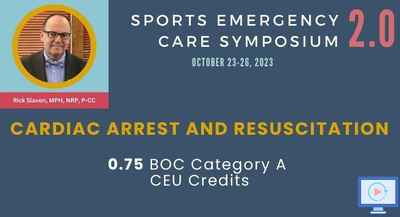Course Info (BOC Domains of Athletic Training; Presentation Description; Learning Objectives; Clinical Practice Gap Statement; Clinical Bottom Line; Summary Conclusions)
BOC Domains of Athletic Training:
-
Domain I - Risk Reduction, Wellness, and Health Literacy
-
Domain II - Clinical Evaluation and Diagnosis
-
Domain Ill - Critical Incident Management
Presentation Description:
Cardiac arrest is a life-threatening event that demands swift and informed action. This presentation delves into the pathophysiology of cardiac arrest and provides insights into when resuscitation may or may not be appropriate. We'll also explore the Chain of Survival concept, emphasizing the critical role of early defibrillation and effective CPR techniques in improving survival rates.
Learning Objectives:
- Describe the pathophysiology of cardiac arrest.
- Identify situations for withholding resuscitative attempts.
- Explain the Chain of Survival for cardiac arrest.
- Discuss the importance of early defibrillation and CPR techniques.
Clinical Practice Gap Statement:
While athletic trainers are skilled in managing sports-related conditions, they may lack in-depth understanding of the complex pathophysiology behind cardiac arrest and the decision-making involved in resuscitative attempts. This gap can significantly impact the quality of emergency care provided, leading to less than ideal outcomes for athletes experiencing cardiac emergencies.
Clinical Bottom Line Statement:
For athletic trainers, gaining a nuanced understanding of cardiac arrest pathophysiology is crucial. Equally vital is the ability to discern situations where resuscitative attempts should be withheld. Understanding and applying the Chain of Survival, along with effective early defibrillation and CPR techniques, can substantially improve survival outcomes in athletic settings experiencing cardiac emergencies.
Summary Conclusion Statements:
- A deep grasp of the pathophysiology of cardiac arrest is essential for making prompt and effective interventions.
- Identifying instances where resuscitation is not warranted is as crucial as knowing when immediate action is required.
- Mastery of the Chain of Survival, especially the roles of early defibrillation and proficient CPR, is indispensable in optimizing cardiac emergency outcomes.


